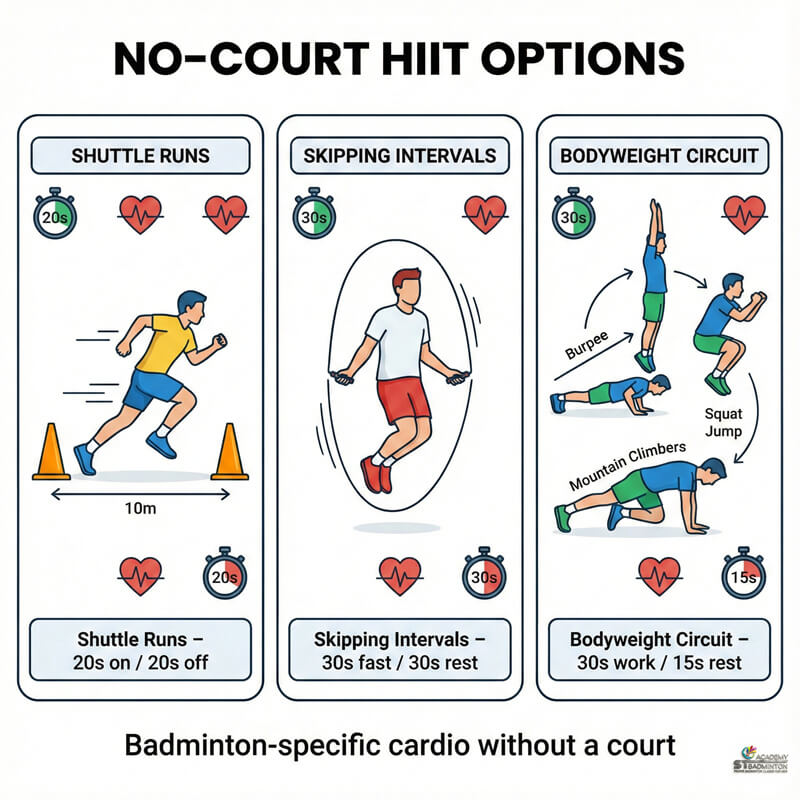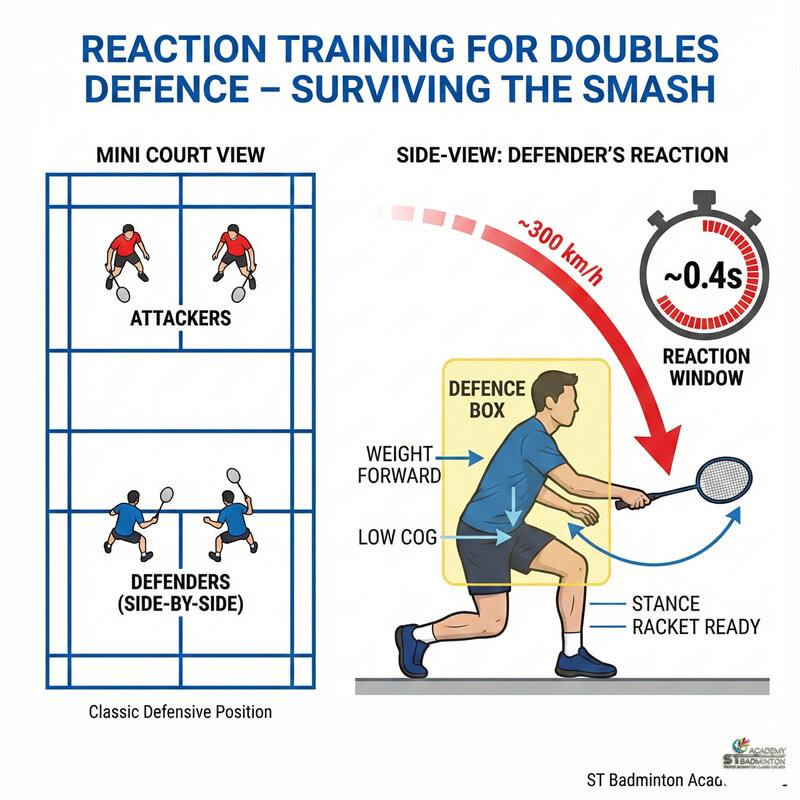How Can You Create A Customized Badminton Training Plan? (Malaysia & Singapore)
As a badminton coach working with families in Malaysia and Singapore, I often meet players who train very hard but without any real plan. Once we organise a simple, customised training schedule that fits their level and weekly routine, they usually feel less lost and see progress more clearly. This page helps players and parents in Setapak, Wangsa Maju, Selayang, Kepong, Cheras and surrounding areas understand how to build a realistic, personalised badminton training plan based on age, skill level, goals, weekly schedule and recovery needs.
A certified badminton coach in Kuala Lumpur and Singapore explains step by step how to create a balanced training structure covering technical, physical, tactical and mental work across weeks and months for kids, school team players and working adults.
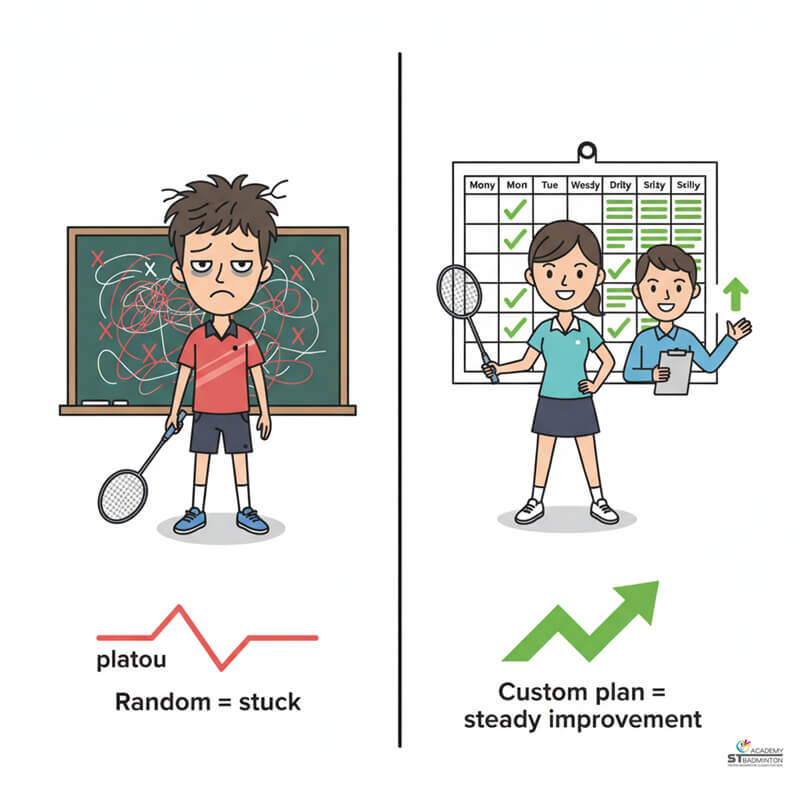
Planning Step #1
Why You Need A Customized Badminton Training Plan
At ST Badminton Academy, our certified badminton coaches work with kids aged 4 and above, school team players, serious juniors and working adults in Malaysia and Singapore who want to improve efficiently. Many players train regularly but without clear structure, which leads to slow progress because training ignores key weaknesses and repeats what they already know.
A simple customised training plan helps you balance technical work, footwork drills, physical conditioning and match play across the week. It prevents overtraining and injuries by including proper rest days and lighter sessions. Most importantly, structured planning makes every trip to the court more meaningful for families travelling around Kuala Lumpur and Singapore.
Good plans address four main areas: technical skills like grip and shots, tactical understanding like when to attack or defend, physical fitness including stamina and strength, and mental focus under pressure. Players from Setapak, Wangsa Maju, Selayang and nearby areas who follow balanced plans see clearer progress over months compared with random drilling or only playing games.
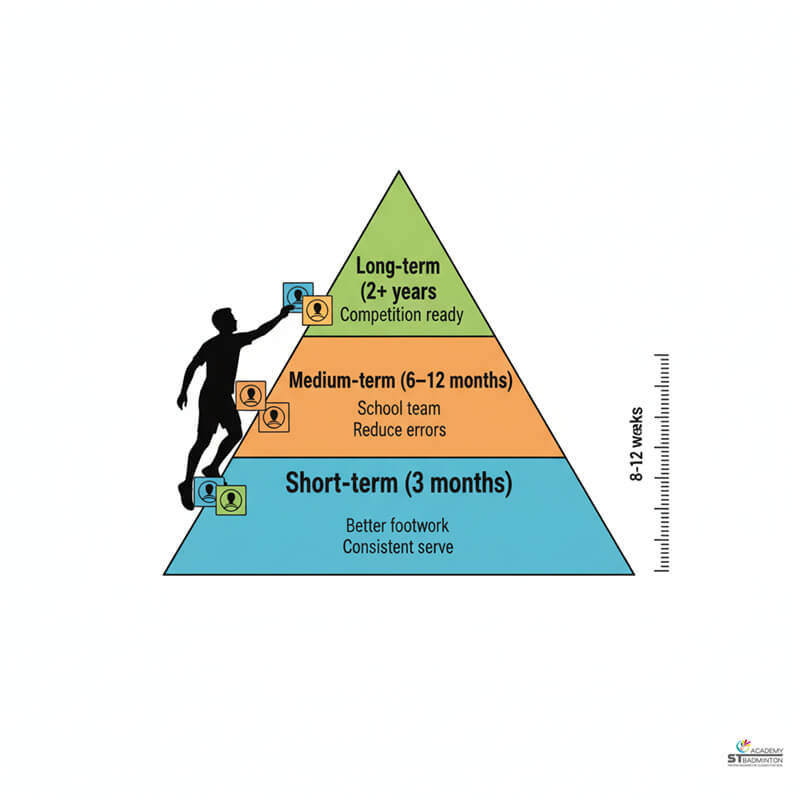
Planning Step #2
Clarify Your Goals And Timeline
Before building a training plan, define clear goals and set a realistic timeframe. Ask yourself what you want to achieve in the next three to six months. Goals can be outcome focused such as joining the school team, winning a club tournament or improving fitness, or they can be process focused like improving footwork speed, reducing unforced errors or building better stamina.
Process goals are often more useful because they give specific training direction and are fully under your control. For example, a junior from Kepong or Cheras might aim to master consistent forehand clears within three months, while a working adult in Singapore might target two badminton sessions per week for six months to rebuild fitness.
Setting a timeline of eight to twelve weeks helps you plan training phases and review progress regularly. At ST Badminton Academy, our certified coaches help players from Ampang, Danau Kota and across Singapore define realistic goals that match their current level, available time and family or work commitments rather than chasing unrealistic “fast results” promises.

Planning Step #3
Assess Your Current Level And Training History
Understanding where you are right now helps create a plan that fits your actual needs. Assess your technical level including grip quality, stroke consistency, footwork patterns and basic shot repertoire. Rate your physical fitness covering stamina, speed, strength and flexibility. Review your competition experience from never played matches to regular school league or club tournaments.
Also consider your training history and any past injuries that might affect loading and exercise selection. A simple way is to rate each area from one to five, where one means beginner and five means very strong. Share this assessment with your certified coach at ST Badminton Academy so they can design appropriate drills and progression.
Players from Sentul, Gombak, Melati Utama and across Singapore including Bishan, Ang Mo Kio and Yishun benefit from honest self assessment because it prevents copying advanced training plans that ignore fundamental weaknesses. Beginners need more time on basics, while intermediate players can handle more complex tactical work and physical conditioning.
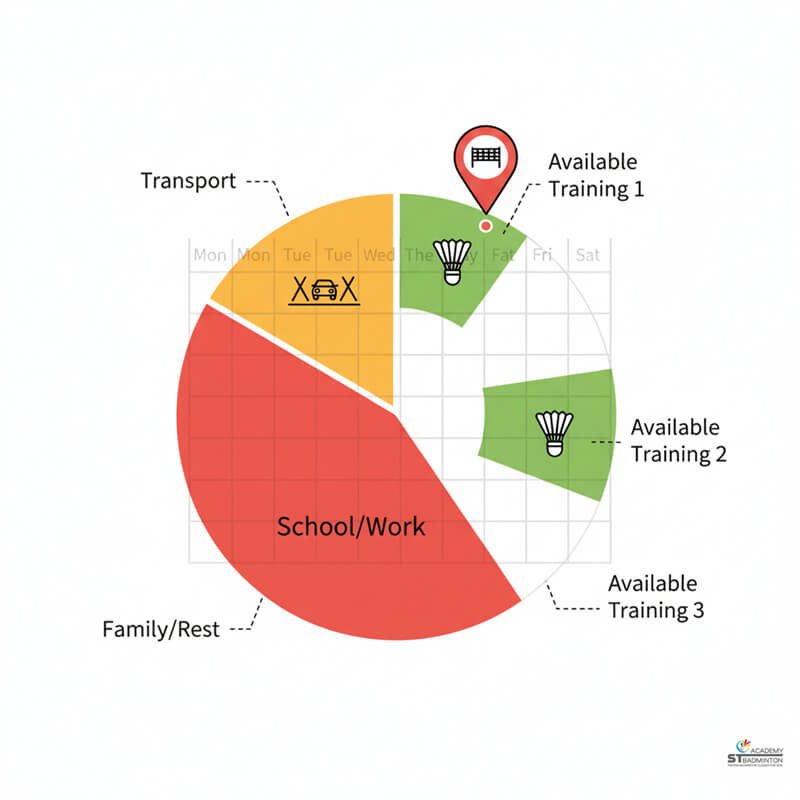
Planning Step #4
Understand Your Time, Location And Resources
Your training plan must fit real life including school timetable, exam periods, work hours, travel distance and budget. Players from Setapak, Wangsa Maju, Cheras, Ampang, Kepong or Petaling Jaya, as well as Jurong, Clementi, Bukit Timah, Toa Payoh and Tampines in Singapore, often have limited training slots due to distance, traffic and other commitments.
For casual beginners, one to two sessions per week is realistic and sustainable. Players aiming for school team selection or regular competition should target two to four sessions weekly, with careful planning as volume increases. Adults balancing work and family may need flexible scheduling with some weeks lighter than others.
Consider court access, coaching availability and whether you can combine on court sessions with home based conditioning work. At ST Badminton Academy, our certified coaches design training plans that respect these practical constraints rather than forcing unrealistic schedules that lead to burnout or missed sessions.
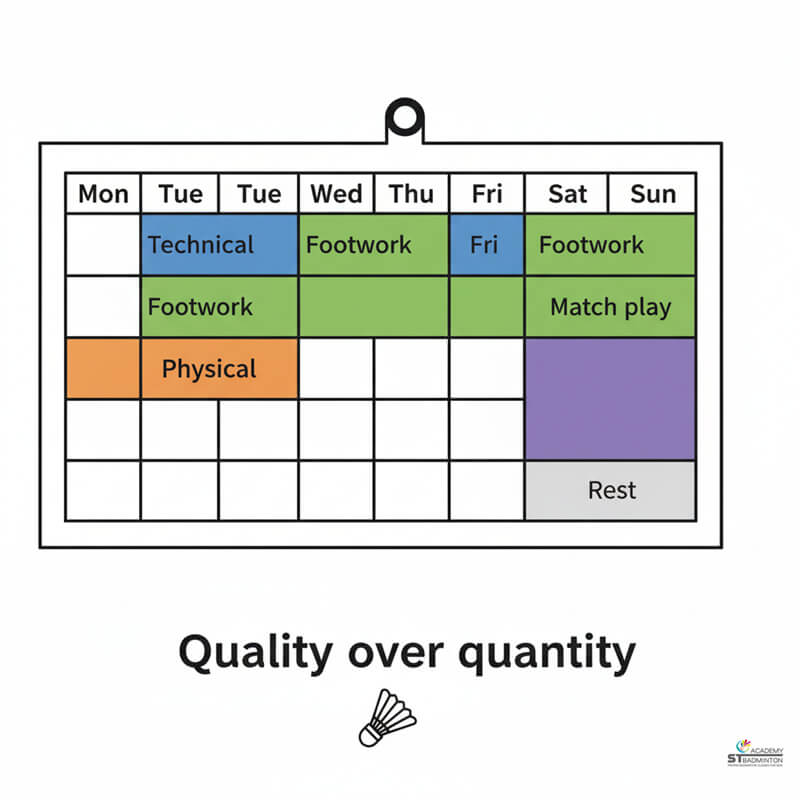
Planning Step #5
Build A Balanced Weekly Training Structure
A complete badminton training week should include several components working together. On court technical training focuses on shots, consistency and shot combinations. Footwork and movement sessions work on shadow drills, multi direction patterns and recovery steps. Physical conditioning covers strength, agility, cardio and flexibility appropriate for your age and level.
Match play and tactical practice help you apply skills under pressure and develop decision making. Recovery includes rest days, lighter sessions and stretching to let your body adapt and prevent overtraining. Beginners might train twice weekly with one technical session and one matchplay session, while serious school team players might schedule four sessions covering technique, footwork, conditioning and matches separately.
Players in Kuala Lumpur and Singapore should avoid training only through games without structured drills, as this leads to repeating mistakes and plateauing quickly. At ST Badminton Academy, our certified coaches help families from Ampang, Petaling Jaya, Subang Jaya, Puchong and across Singapore design weekly schedules that mix all these components based on available time and training goals.
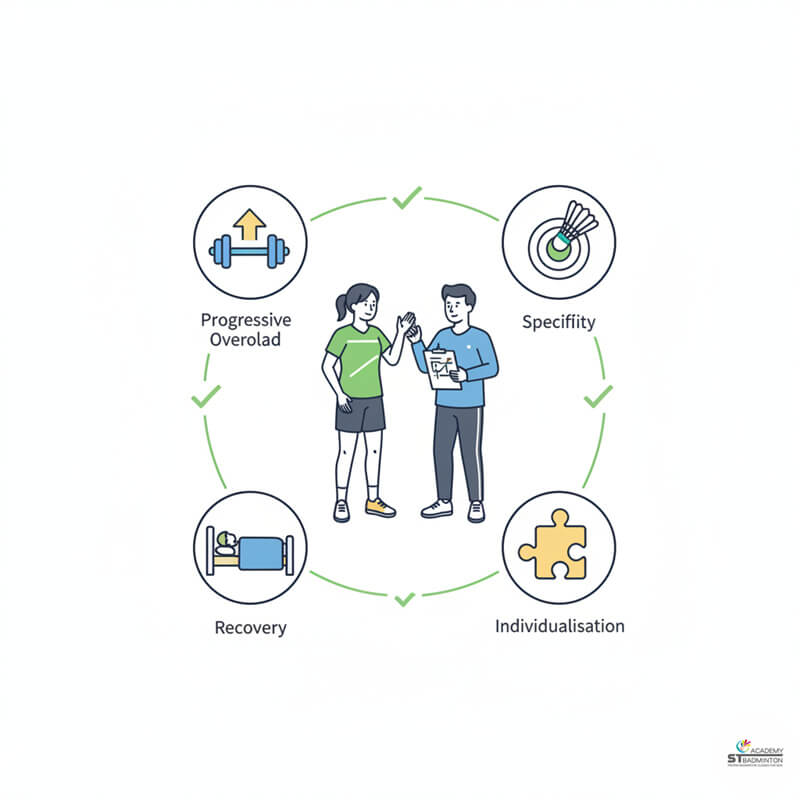
Planning Step #6
Follow Key Training Principles
Good training plans follow simple principles that help you improve safely over time. Progressive overload means increasing difficulty gradually over weeks by adding more repetitions, faster footwork or longer rallies rather than jumping to advanced work immediately. Specificity means training what you want to improve, so if you need better net play, include targeted net drills rather than only smashing.
Recovery is essential because your body adapts and gets stronger during rest, not during the training itself. Include rest days and lighter sessions each week. Individualisation means the plan must match your age, current level, injury history and life circumstances rather than copying someone else’s schedule.
Science based planning for badminton emphasizes structured phases and sensible training to competition ratios, especially for juniors who are still developing physically. Players from Kuala Lumpur and Singapore who respect these principles see steady improvement without burnout or injuries that force long breaks from training.
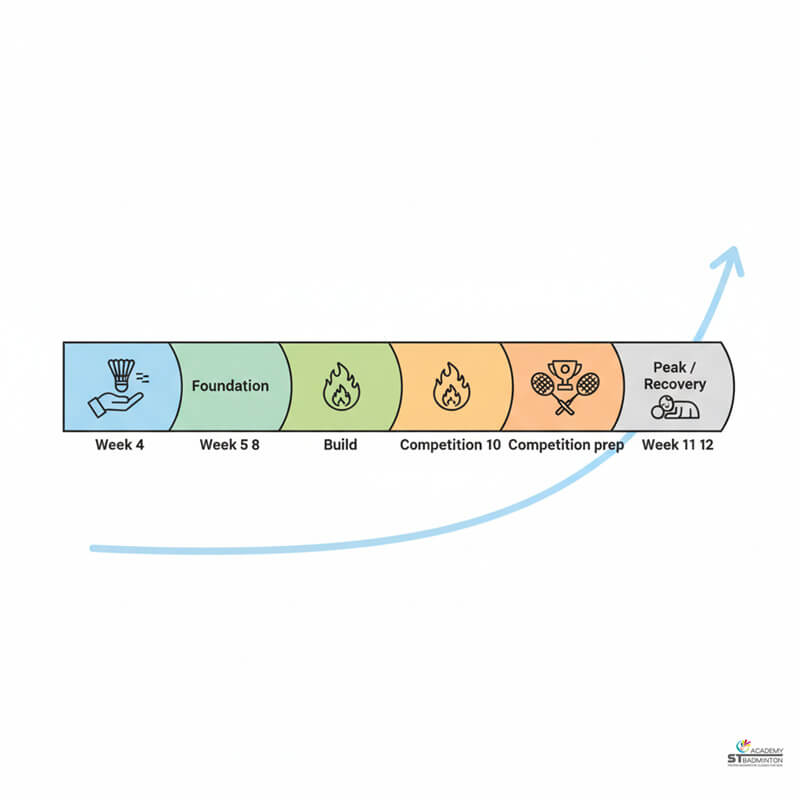
Planning Step #7
Plan By Phases Using Basic Periodization
Periodization means organizing training into phases with different focuses over weeks and months. A foundation phase builds basic technique and general fitness through simple drills and moderate volume. A build phase increases intensity by adding more specific footwork, longer rallies and targeted physical conditioning. A competition phase includes more match play, sharper sessions and careful load management to stay fresh for tournaments.
A recovery or transition phase after busy periods uses easier weeks with lighter training to let your body recover fully before starting the next cycle. Instead of training the same way every week all year, players in Malaysia and Singapore can think in eight to twelve week blocks with clear goals for each phase.
For example, a school team player from Hougang, Sengkang or Tampines might spend eight weeks building footwork and stamina during term break, then shift to more tactical and match work as the school league approaches. At ST Badminton Academy, our certified coaches design periodized plans that align with school calendars, exam periods and competition schedules for families across Kuala Lumpur and Singapore.
FAQs: Creating A Customized Badminton Training Plan
Here are answers to common questions from players and parents in Malaysia and Singapore about building personalized badminton training schedules.
How many times a week should my child train badminton in Setapak or Kuala Lumpur?
For kids aged 4 to 10 who are beginners, one to two sessions per week is suitable and sustainable. School team players aged 11 and above aiming for competitive improvement can train two to four times weekly with a mix of technical drills, footwork and match play. At ST Badminton Academy in Kuala Lumpur, our certified coaches adjust volume based on age, school schedule and body readiness for children from Setapak, Wangsa Maju, Selayang and nearby areas.
What should a basic weekly badminton training plan include for beginners in Singapore?
A basic plan for beginners should include one on court technical session covering grip, basic shots and footwork, plus one matchplay or sparring session to practice under pressure. Add simple home based stretching or light conditioning if possible. Rest days are essential. Players from Jurong, Hougang, Sengkang and other Singapore areas benefit from starting with this balanced structure before increasing volume as skill and fitness improve over months.
Can I still follow a badminton training plan if I am very busy with work in Malaysia?
Yes. Working adults should create realistic plans matching their actual schedule. Training once or twice weekly is fine if sessions are well structured covering technical work, movement and some conditioning. Some weeks may be lighter due to work projects. The key is consistency over months rather than forcing intensive training that leads to burnout. Our certified coaches in Malaysia help adults from Kepong, Cheras, Ampang, Petaling Jaya and surrounding areas design flexible plans.
How do I plan badminton training around school exams in KL?
Reduce training volume during exam periods by cutting one or two sessions per week or shortening session length. Maintain basic movement and skill work with lighter intensity. After exams, gradually rebuild volume over a few weeks. At ST Badminton Academy, we plan training phases around school calendars for students in Kuala Lumpur and Selangor. Forcing heavy training during exam stress increases injury risk and affects academic performance negatively.
Do beginners need a customized training plan or is random play enough in Kuala Lumpur?
Beginners benefit greatly from simple structured plans that address technical fundamentals, basic footwork and consistency rather than only playing games. Random play ignores weaknesses and leads to slow progress or bad habits that take months to correct later. Even a basic plan with clear focus areas accelerates improvement. Our certified coaches help beginners from Kuala Lumpur start with appropriate structure that makes every session productive.
When should I add physical training sessions to my badminton plan in Singapore?
Add dedicated physical training when you already have solid technical fundamentals and train at least three times weekly. Start with basic bodyweight exercises for strength, agility drills and simple conditioning. Kids should focus on movement quality over heavy loading. Serious juniors and adults from Bishan, Ang Mo Kio, Yishun, Tampines and across Singapore can integrate one or two conditioning sessions weekly alongside on-court work under guidance from certified coaches.
How should I adjust my training plan when I feel very tired or busy in Malaysia?
Listen to your body and reduce training intensity or volume when feeling fatigued from school, work or previous training. Skip one session, shorten others or focus only on light technical work without heavy physical load. Proper recovery prevents injuries and illness that force longer breaks. Players in Malaysia who adjust plans flexibly maintain long term consistency better than those who ignore fatigue signals and risk burnout or injury.
How often should I review and update my badminton training plan near Setapak or Wangsa Maju?
Review your plan every four to eight weeks to assess progress, adjust goals and modify training focus based on what improved or still needs work. Also adjust when life circumstances change such as exam periods, work projects or recovery from minor injuries. At ST Badminton Academy in Setapak, our certified coaches help players from Wangsa Maju, Selayang and nearby areas refine their plans regularly to maintain steady improvement over months.
When should I seek help from a certified coach to redesign my training plan in Singapore?
Seek coach guidance when progress plateaus for several months, when recovering from injury, when preparing for important competitions, or when unsure how to structure training as you move from beginner to intermediate level. Our certified coaches in Singapore have experience designing age-appropriate, goal-specific plans for players across skill levels from casual recreation to serious competition, ensuring safe and effective long term development.
Structured Badminton Training In Action

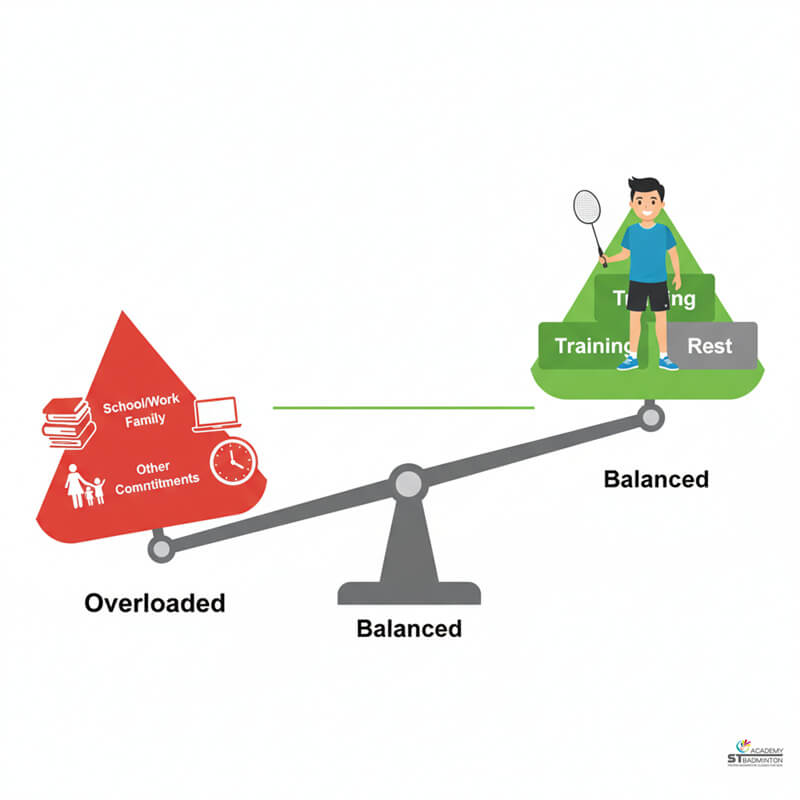
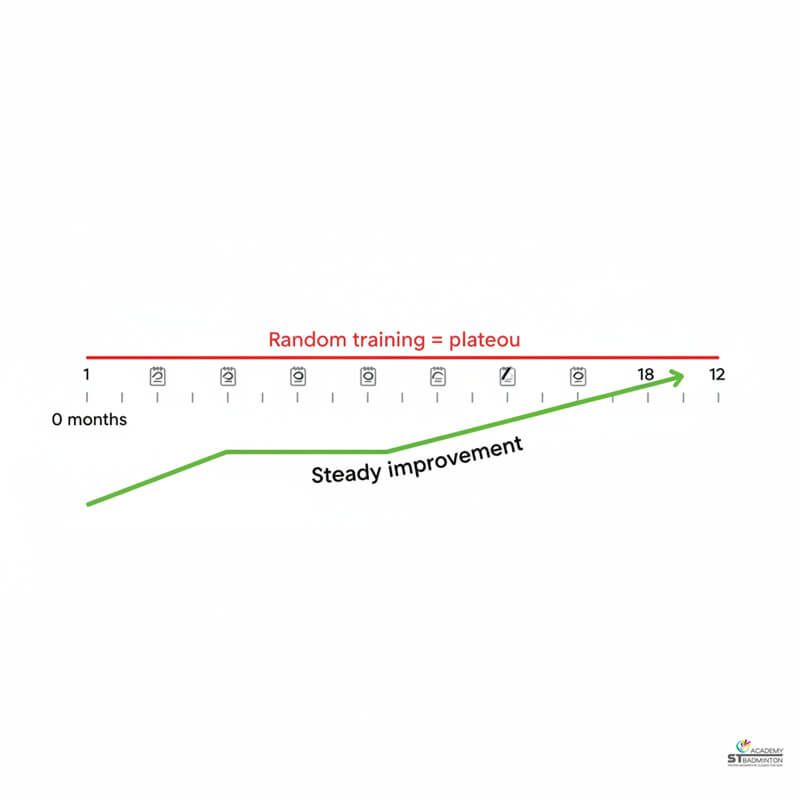
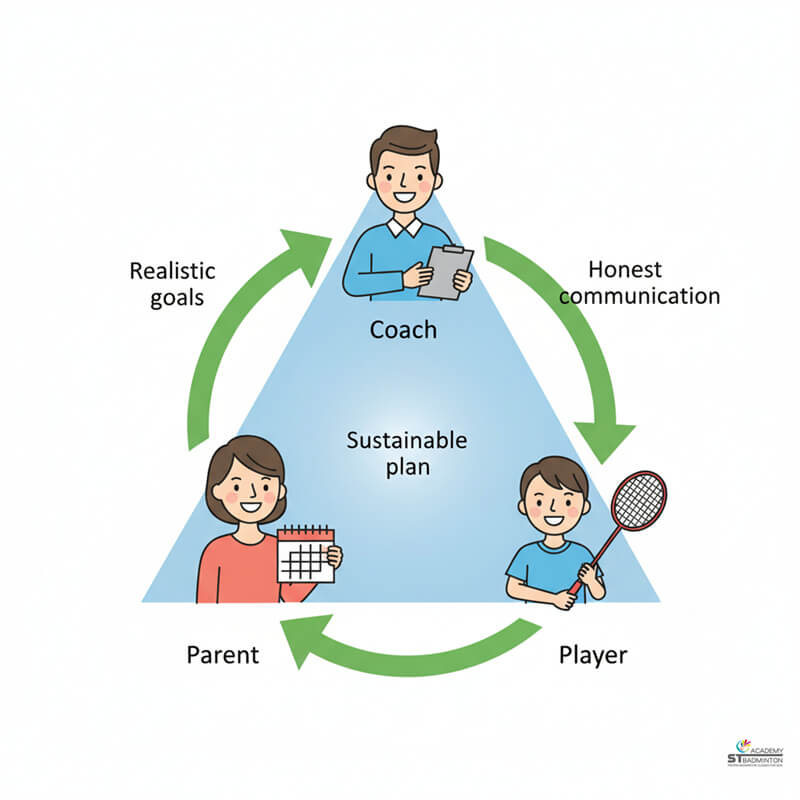
Benefits Of Following A Customized Badminton Training Plan In Malaysia And Singapore
Creating a personalized training plan based on your age, level, goals and weekly schedule helps you improve faster while avoiding overtraining and injuries. Our certified coaches across Kuala Lumpur and Singapore help players develop realistic structures that fit real life and produce steady long term progress.
| Planning Area | Random Training Without Plan | Customized Training Plan At ST Badminton Academy STRUCTURED |
|---|---|---|
| Goal Setting | No clear goals, just train and hope for improvement somehow without direction or timeline. | Define specific outcome and process goals with realistic 3 to 6 month timeline. Focus on measurable targets like footwork speed or consistency. |
| Weekly Structure | Play random games whenever court is available. No balance of technical, physical, tactical and mental training. | Balanced schedule covering on-court technique, footwork, conditioning, match play and recovery based on available time and level. |
| Training Volume | Train very hard whenever motivated then skip weeks randomly. No consideration for rest or adaptation. | Progressive overload increasing difficulty gradually. Include rest days and lighter weeks to let body adapt and prevent overtraining injuries. |
| Age Differences | Kids, teens and adults all copy the same training without considering physical development or life circumstances. | Kids focus on fundamentals with shorter sessions. Teens add structured conditioning. Adults respect work stress and recovery needs. |
| Periodization | Same drills and intensity every week all year. No training phases or competition preparation planning. | Organize training into foundation, build, competition and recovery phases over 8 to 12 week blocks with clear focus for each phase. |
| Life Balance | Force intense training regardless of school exams, work projects or family commitments leading to burnout. | Plan fits real life including school timetable, exam periods and work hours. Adjust flexibly when circumstances change without guilt. |
| Progress Tracking | No tracking or review. Cannot tell if training is actually working or just wasting time and effort. | Keep simple training log noting sessions and performance indicators. Review progress every 4 to 8 weeks and adjust plan based on results. |
Create Your Customized Badminton Training Plan In Kuala Lumpur And Singapore
This guide explains step by step how to build a realistic, personalized badminton training plan that balances technical work, footwork, physical conditioning and match play based on your age, level, goals and weekly schedule. ST Badminton Academy provides coaching that helps kids aged 4 and above, school team players, serious juniors and working adults from Setapak, Wangsa Maju, Selayang, Kepong, Cheras, Ampang and surrounding areas design structured training that fits real life and produces steady long term progress. Contact us to create your customized plan with certified coach guidance.

